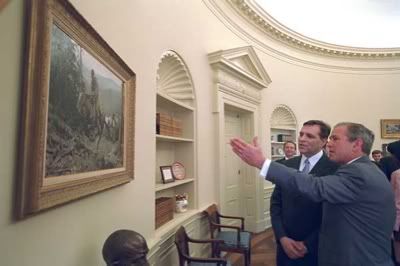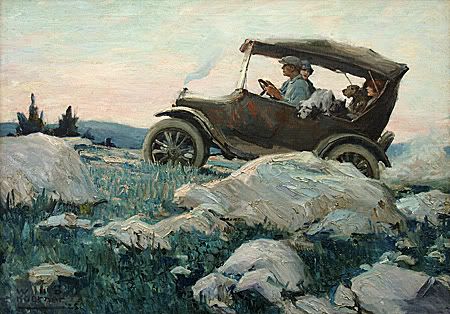|
Horseshit! Bush and the Christian Cowboy
So what, you say? So what if the President fudges the name of a western painting, and so what if he uses the theme of the Christian cowboy in his official campaign biography, and in his scripted talking points to Oval Office visitors? Well, this carefully constructed myth of the Christian cowboy is the central metaphor and theme that Bush artfully employs to rally the Christian conservative base with whom he's identified himself. This is the President's brand: the Christian cowboy is his logo and "A Charge To Keep" is his tagline. And the President's brand is built around a manufactured image - a lie - created to pander to his base for crass political gain. There is no truth, no authenticity to the Presidential brand. It is, in a word, horseshit. So what's the real story behind this once-obscure but now famous western illustration by a German immigrant named William H.D. Koerner, and what was the artist's true inspiration? Bear with me through the details; the revelation will be worth the wait. Gergen: 'Is he leading up a mountaintop...or over a cliff?' David Gergen believes that Bush's identification with Mr. Koerner's painting says something important about the qualities of his leadership. And Mr. Gergen knows something about what presidential leadership requires. He advised Presidents Nixon, Ford, Reagan, and Clinton, and now directs the Center for Public Leadership as a professor at the John F. Kennedy School of Government at Harvard University. In the Fall 2003 issue of the school's magazine Compass: A Journal on Leadership, Gergen wrote: "Bush's personal identification with the painting, which now hangs in the Oval Office, reveals a good deal about his sense of himself as a political leader--who he thinks he is, the role he plays, and the centrality of his religious faith.... His followers today tend to see in Bush what he sees in the painting: a brave, daring leader riding fearlessly into the unknown, striking out against unseen enemies, pulling his team behind him, seeking, in the words of Wesley's hymn, "to do my Master's will." They see him as a straight shooter and a straight talker. They take comfort in his religious faith and think he is leading us toward a mountaintop." Ah, horseshit. He's riding recklessly up a cliff, believing he's on a God-given mission and enjoying it so much that he does not heed whether his horse is about to get crippled on the slick shale underfoot. The President, in macho mode, cannot imagine the possibility of leading his imaginary Christian nation right off a cliff. And so that is just what happens. As the Good Book says, "They are a nation without sense, there is no discernment in them.... In due time their foot will slip; their day of disaster is near and their doom rushes upon them." (Deuteronomy 32:28, 35) Writing for Compass, Gergen concludes: [Bush's] style of leadership encourages short-term thinking, and as we are now realizing, the flip side of boldness can be recklessness. Inevitably, as we step back and see Bush whole, our imaginations are drawn again to that painting by W.H.D. Koerner: should we celebrate the daring young rider as he scrambles up that tough terrain? Is he leading up a mountaintop...or over a cliff? Bush may have been more provocative than he knew in hanging it in the Oval Office. The painting hangs to the left of the President's desk, above a bust of President Eisenhower, and Mr. Bush invariably ends his guided tours of the Oval Office by reciting a few talking points about it. It's a pity he doesn't know a thing about the artist who painted it, or the hilarious, original name of the piece, or the fact that it has nothing to do with religion. Mr. Bush's Guided Tour When you visit the Oval Office, the President likes to point out that, heh, see, it's actually oval. (Who knew?) Then he marches you around the office, pointing out its features and appointments, starting with the rug on which you're standing. Did you know that every President gets to design a rug? Well, this one was designed by Laura. See how the rays radiate from the Presidential seal? They're sunbeams: meant to project optimism. It's very important that a President be seen as optimistic, "because they're watching me like a hawk," and a President cannot be seen to wring his hands if he thinks he's made a bad decision, because then people will realize. Mr. Bush tells Oval Office visitors from Germany: "You cannot lead people unless you're optimistic about what you're doing. You've got to believe it in your very soul. One of the interesting things about the presidency is people watch me like a hawk. They're looking at my moves. And if I'm going to be wringing my hands and if I'm all worried about the decisions I make are not going to lead to a better tomorrow, they'll figure it out. And so when you talk to me today, I just want you to know I not only strongly believe in the decisions I make, I'm optimistic that they're going to work -- very optimistic."Message: keep projecting sunny optimism, especially when you know you've put your foot in it, because if you show panic, the crowd will swoop in like a hawk, ready to point and laugh at its prey. Mr. Bush's Olde Time Brand Identity: Keep projecting Christian cowboy optimism and never slow down or turn around despite all evidence of imminent danger or "they'll figure it out." He stops by three paintings by Julius Onderdonk, including one of a hillside of bluebonnets -- the Texas state flower. And in an unguarded moment, he says that some days, he stares at it, trying to project himself into that field of bluebonnets back home. He sure misses Crawford. He points out the antique desk -- a gift to President Rutherford B. Hayes from Queen Victoria in 1880, made from timbers salvaged from HMS Resolute, which was rescued in Antarctica. And finally, he stops in front of the cowboy painting, and begins to recite a myth that his handlers told him to repeat every time he gives a tour around the office which as we can see, really is oval. (Golly!) He's told the myth countless times, and it has been reflexively recorded by journalists from Germany, Great Britain, and the United States. But no one checks the facts, because it's such a great story and the myth about the painting makes such a wonderful symbol of religious zeal and no-holds-barred leadership. The Authorized, Mythical Version Okay. So here's the officially approved version first. When Mr. Bush was inaugurated Governor of Texas in January 1995, his wife Laura picked out for the ceremony a good old Methodist hymn by Charles Wesley, "A Charge To Keep." One of the attendees was Mr. Bush's childhood buddy "Spider," better known as the oil tycoon Joseph I. O'Neill III. Mr. O'Neill has raised more than $100,000 for Mr. Bush in each of the last two presidential campaigns, and he and his wife Jan have been overnight guests at the White House and Camp David. Mr. O'Neill is now managing partner of O'Neill Properties Ltd., his family's oil and investment business. Mr. Bush and Mr. O'Neill go way back together. When they were boys, "Bushie" and Spider played Little League baseball on a team coached by future President George H. W. Bush. When they grew up and Bushie decided to run for Congress, Joe and Jan threw a backyard barbecue in July 1977, and invited one of Jan's friends -- a Southern Methodist University graduate named Laura Welch -- over for a fix-up with the cocky candidate. As Laura tells it, she and George were about the only two singles left in Midland, Texas. But Bushie's mother, Barbara Bush, paints a more romantic myth: "Georgie" and Laura fell madly in love. In any case, the couple got married four months later -- proof that Bushie could make a decision fast and stick with it. As Mr. O'Neill tells it, he introduced Mr. Bush to his wife Laura. But that's a bit of revisionist history; Bushie and Laura had actually attended the same elementary school, and later lived in the same apartment building even before the O'Neills threw their barbecue. Who cares? It's just a little fact-fudging that helps position Mr. O'Neill as the official maker of Presidential myth. No harm there, right? Years later, as Mr. O'Neill tells it, Bushie had become a roaring drunk. The men and their wives were at a birthday dinner in the Broadmoor Hotel in Colorado Springs -- pounding down drinks and holding down the raucous corner table that drew other diners' sideways glances. Laura whispered to George that in his state, he might do something to embarrass his father. And hey, presto! On the spot, George swore off alcohol, went cold turkey, and never took another drink. And Bushie suddenly swapped out his alcohol addiction for a devotion to physical exercise and regular Bible study with a men's group in Laura's Methodist church. Spiritual exertion spurred on by physical exercise can be a heady combination -- just the stuff for a zealous cowboy bounding up a steep and slippery slope, heedless of the danger to his horse. So Mr. O'Neill was there at key turning points of Bushie's life, witnessing events and burnishing the myth. And the gubernatorial inauguration, and the singing of Wesley's hymn inspired him to make a generous offer. He said, "Look, I've got a painting based on that hymn." Would Bushie like to hang it in his office?
"I said, yes, I'd love to," the President tells a group of Oval Office visitors from The Washington Times. "And so it's been on the wall ever since I've been the governor and president. And I love it. He's a determined horseman, a very difficult trail. And you know at least two people are following him, and maybe a thousand. And the hymn talks about serving the Almighty. So it speaks to me personally." See the shift from the image of the cowboy to the citation of the hymn, which has nothing to do with the western rider, and then the leap that this shows how Mr. Bush is on a holy mission? See how Mr. Bush takes the two followers depicted and turns them into a host of a thousand followers -- sometimes, he says "two thousand" -- through his magical thinking? In his official campaign biography, A Charge To Keep (1999) - which Bushie jokes is actually "a novel, some say fact, some say fiction," that was ghosted by Karen Hughes -- the incident is described as follows: I started the [gubernatorial inauguration] day with a church service. One of the hymns I selected is titled "A Charge to Keep I Have." Written by Charles Wesley, the words say: Wrong! The Christian cowboy myth does not even get the Christian part right. Mr. Wesley's hymn was not inspired by I Corinthians 4:2. In fact, Mr. Wesley lifted his hymn directly from a Christian classic, a Bible commentary written from 1706-1721 by Matthew Henry, who was expositing a passage in Leviticus. Concerning Leviticus 8:35, where the temple priesthood is instructed to "keep the charge of the Lord," Henry wrote: We have every one of us a charge to keep, an eternal God to glorify, an immortal soul to provide for, needful duty to be done, our generation to serve; and it must be our daily care to keep this charge, for it is the charge of the Lord our Master, who will shortly call us to an account about it, and it is at our utmost peril if we neglect it." Spider said that the lead cowboy reminded him of Bushie. Governor Bush hung the piece opposite his desk in Austin, and wrote a memo to staff, inviting them to come witness it. "I thought I would share with you," Governor Bush wrote, "a recent bit of Texas history which epitomizes our mission. When you come into my office, please take a look at the beautiful painting of a horseman determinedly charging up what appears to be a steep and rough trail. This is us. What adds complete life to the painting for me is the message of Charles Wesley that we serve One greater than ourselves." That's the official version that Spider is burnishing into a fine cowboy myth. To preserve the myth, Mr. O'Neill serves on the board of a group that bought and preserved Bushie's childhood home in Midland, hoping one day to annex the house to a Presidential library. Maybe the painting will come to roost there. For sure, this blogger piece will not be found in the archives of the Bushie library. But so what? Only here can you find... The Unauthorized, Myth-Busted Version Oh, please. The painting illustrated a short story by Ben Ames Williams, published by Country Gentleman Magazine in 1918. And the name of that story was "A Charge To Keep." But that doesn't mean the painting shares the story's title. No, Mr. Koerner actually created the painting to illustrate a short story by William J. Neidig, published in the June 3, 1916, edition of The Saturday Evening Post. The cover art was by Norman Rockwell, the issue sold for a nickel, the story was illustrated by W. H. D. Koerner, and the name of the story was "The Slipper Tongue." Now that sounds a lot more like the authentic Bushie. Isn't Bushie famous for his own slippery tongue, and his malaprops? Just last week, the President gave a tour of the Oval Office, to a German newspaper, and talked about the Koerner painting, and how it reminds him of his holy mission. The Germans got to talking about religion; they asked about the President's opinion of the new German pope. And Mr. Bush lauded the last two popes, or at least he intended to laud them, but accidentally insulted them. You cannot make up this stuff. Here's the official White House transcript, dated May 5, 2006, in which, as of this writing, they have not yet corrected the President's embarrassing slip of the tongue. What he meant to say was that the popes challenge the concept of "moral relativism." But here's what Mr. Bush actually said: I admire the two Popes. These are strong, capable men who challenge the concept of moral relevancy. Ladies and gentlemen, the President of the United States, Mr. George W. Slipper Tongue, who shall deliver an address on how the papacy is morally irrelevant. Your attention, please. The Saturday Evening Post loved the illustration to "The Slipper Tongue" so much that it reprinted the piece again the following year, to accompany another short story by George Patullo titled, "Ways That Are Dark." Wow, the way that careless cowboy resembles Bushie is downright eerie. And only in 1918 did the same illustration get recycled in Country Gentleman. From Mr. Koerner's viewpoint, you could call his painting whatever you like, if you were willing to pay for the privilege, but it was originally titled, and inspired by, "The Slipper Tongue." Mr. Koerner's daughter Ruth Koerner Oliver explained to the Los Angeles Times in an interview dated January 28, 1994, that her father's inspiration came directly from studying the magazine stories that he illustrated. "The magazine would send my father a story. He would read it and pick out a part (to illustrate) that he thought would make people read the story. You have to remember that this was long before radio and television, so people had to read in those days. The magazines were in their prime years." And Mr. Koerner himself confirmed that he drew his inspiration directly from the stories he illustrated in a 1932 interview. "I try to draw the man the author describes . . . I concentrate on the character until it comes alive and I can see him in my mind's eye." (W.H.D. Koerner, quoted by Wesley Stout, "Yes, We Read the Story," The Saturday Evening Post, June 25, 1932, p. 38.) The Man: President George W. Bush. The Myth: "A Charge To Keep": one reckless cowboy's call to serve a holy mission, heedless of risk or consequence. The Truth Revealed: A Saturday Evening Post illustration for two short stories, "The Slipper Tongue" and "Ways That Are Dark." No religious significance. Just a couple of colorfully illustrated, rollicking western tales in a curl-up-and-read magazine that sold for a nickel. Mr. Koerner would be confounded.
But now there is a Koerner painting that does aptly illustrate the Bushie presidency. It's called "Boiling Over." The piece graced the cover of the Saturday Evening Post in 1925 and it reads like a parody of the one that Bushie calls "A Charge To Keep." Here, the reckless cowboy is replaced by a feckless driver. And the horse in danger of becoming crippled is replaced by an overheated jalopy. Our modern-era western rider is slipping the transmission belts of a 1925 Ford Model T touring car, trying in vain to tackle a rocky slope. He leans forward as if to spur his suffering mount, while his Ma and girlfriend throw him icy stares. Two dogs are along for the ride; one decides to bail. The dog is hanging his head over the side door, looking for a way out of this lunacy. As the car cruises to a halt, shy of the mountain peak, radiator sputtering in crisis, the dog spots a clear landing and prepares to make a leap of faith. The dog, at least, appears smart enough to scout the ground first, so he does not land in a pile of horseshit.
Horseshit! Bush and the Christian Cowboy | 32 comments (32 topical, 0 hidden)
Horseshit! Bush and the Christian Cowboy | 32 comments (32 topical, 0 hidden)
|
||||||||||||
| ||||||||||||




 print page
print page


